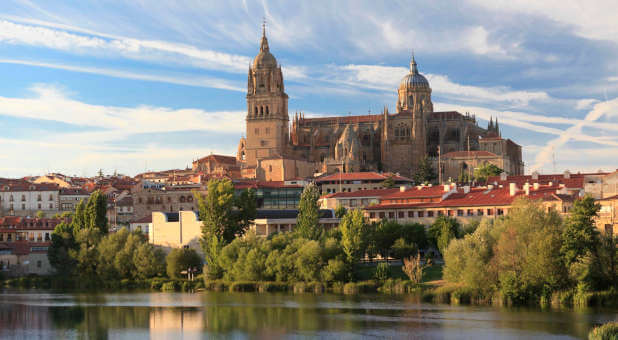The Salamanca Cathedral is a magnificent testament to the architectural brilliance and rich history of 16th-century Spain.
This towering icon, comprised of two churches, one dating back to the 12th and 13th centuries, has long been a prominent landmark and showcases the distinctive Spanish Gothic style.
However, it is not only its age and stunning design that has captured the attention of visitors.
Carved into the exterior walls, amidst intricate patterns, lies a peculiar figure that has ignited wild theories among the time-traveling community.
Believed by some to be a 16th-century depiction of an astronaut, this figure is depicted leaning against intricately carved leaves.
On first glance, it appears to be a stone-clad spaceman, complete with a space suit, boots and a helmet. Fueling the fire of speculation, social media platforms are abuzz with discussions and theories surrounding this enigmatic carving.
Many enthusiasts of time travel boldly claim that this astronaut carving is “definitive evidence of time travel.” The internet is teeming with excitement as people share their thoughts and opinions on how this cosmic visitor found its place within Salamanca Cathedral.
One Twitter user exclaimed, “Astronaut at Salamanca Cathedral: This statue is affirmed as absolute proof of time travel.”
However, there are those who offer a less fantastical explanation for this celestial carving. They argue that the astronaut is a modern addition to the ancient structure, added during the church’s restoration work in 1992.

While the 1992 restoration work put the mystery of the Salamanca astronaut to rest, there are still other intriguing art anomalies that baffle both time travel believers and art enthusiasts alike.
Just last month, major news outlets reported the discovery of what appears to be an iPhone in a painting created almost 90 years ago.
Umberto Romano’s 1937 masterpiece, “Mr. Pynchon and the Settling of Springfield,” predates the advent of the Apple smartphone by about 70 years. However, upon closer inspection of the mural’s bottom right corner, a man can be seen holding a device that resembles a modern smartphone. Speculators claim that he is using his thumb to scroll through his social media feed.
This mysterious gadget has sparked intense speculation, leading art experts to offer their interpretations of its true nature. Some suggest it could be a pocket-sized mirror or a knife, items that would have fascinated people of the time just as much as a contemporary iPhone.
Unfortunately, the artist passed away in 1982, well before the rise of mobile phones. The true intention behind this primitive yet eerily familiar object in his iconic piece remains unknown.
Nevertheless, these discoveries serve as reminders of the extraordinary clues that can be found in unexpected places, fueling our imagination in a world of exponential technological growth. While the explanation behind the Salamanca astronaut may be down-to-earth, the allure of the unknown continues to beckon us to explore the mysteries just beyond our reach.
In the enchanting tapestry of history and art, the presence of anomalies and unexplained curiosities keeps us intrigued, inspiring us to delve deeper into the mysteries that surround us.
Yet with the study of historical mysteries, there must also always be a grounding in the Word of God. The wisdom derived from studying the Bible and daily prayer will solidify one’s spirit against the deceptions of the enemy. As it says in 1 John 4:1, “Beloved, do not believe every spirit, but test the spirits to see whether they are from God, because many false prophets have gone out into the world.”
James Lasher is Staff Writer for Charisma Media.








































